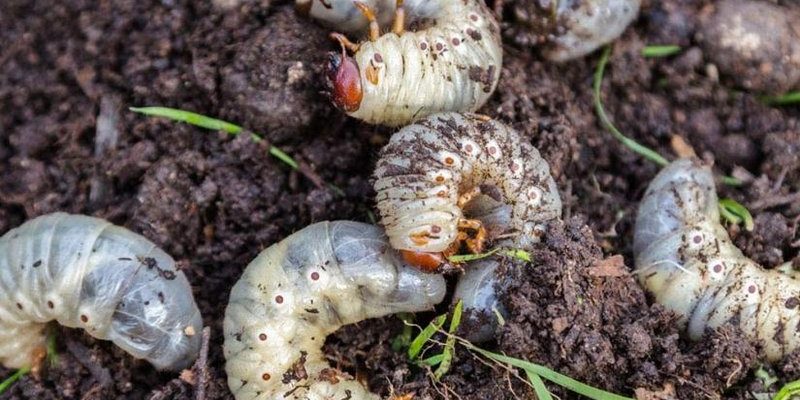
So, what are grubs, exactly? They’re the larval stage of certain beetles, and they love to feast on plant roots. When drought conditions hit, you might expect them to slow down. However, the truth is, they adapt to these harsh environments in ways that might surprise you. Let’s dive deeper into this intriguing topic and uncover how drought influences grub worm activity and what it means for your yard.
What Are Grub Worms?
Grub worms are the juvenile forms of beetles, like the Japanese beetle or the masked chafers. They typically have a C-shaped body, usually white or cream-colored, with a brown head. These little guys are mostly found underground, munching on the roots of grass and other plants. You might not see them often, but they play a crucial role in the ecosystem.
The life cycle of a grub begins when beetles lay eggs in the soil. Once they hatch, the grubs go on a feeding frenzy, which can last for several weeks before they pupate and eventually emerge as adult beetles. This process is influenced by a variety of factors, including water availability. During drought conditions, their behavior changes, and that’s what we’ll explore next.
How Drought Affects Grub Worm Behavior
Drought can significantly alter the environment for grubs. With less moisture in the soil, these pests face a tougher situation. They might remain in a state of dormancy, waiting for better conditions, or they might adapt in unexpected ways.
In dry soil, grubs dig deeper to find moisture. This can sometimes move them closer to the roots of plants, which makes your lawn and garden more susceptible to damage. Surprisingly, they can also become more aggressive in their feeding habits as they compete for dwindling resources.
Here’s the thing: when grubs are stressed, they tend to feed more voraciously. This means that if you notice your grass turning brown or wilting more than usual in a drought, grubs might be part of the problem. Understanding their behavior can help you identify if you need to take action.
Signs of Grub Infestation
You might be wondering, “How can I tell if I’ve got grubs in my yard?” Well, there are a few telltale signs to watch for. Here are the most common indicators:
- Browning Patches: If you see patches of grass that are brown and dying, it could be due to grub feeding.
- Easy Pull-Up: Grass that pulls up easily from the ground often indicates root damage from grubs.
- Presence of Animals: If you notice more birds or animals digging in your yard, they might be after those tasty grubs.
If you’re paying attention to these signs, you can catch potential infestations early on before they wreak havoc on your lawn.
Managing Grubs During Drought
Now that we’ve covered what grubs are and how drought affects their behavior, let’s talk about managing them effectively. Here are a few strategies to consider:
- Regular Monitoring: Check your lawn regularly for signs of grubs, especially during dry spells.
- Moisture Management: Water your lawn appropriately. Overwater and you could create favorable conditions for grubs; underwater and the stressed grass can’t outcompete them.
- Beneficial Nematodes: These microscopic worms can be a natural way to control grub populations without harsh chemicals.
It’s important to strike a balance in lawn care during drought conditions. Keeping everything healthy and hydrated helps your grass stand strong against grub attacks.
Natural Predators of Grub Worms
One of the best ways to manage grubs is to encourage their natural predators. Birds, foxes, and even certain types of beetles are known to feast on grubs. By creating an environment that attracts these helpful critters, you can naturally reduce grub populations.
You might want to consider adding bird feeders, planting native flowers, or even providing small water sources to attract birds. These natural predators can help keep the grub population in check without the need for chemical treatments.
Preventing Future Grub Issues
Prevention is key when it comes to managing grubs in your yard. Here are some proactive steps you can take:
- Healthy Soil: Regularly aerate your lawn to improve soil health, making it less hospitable for grubs.
- Proper Lawn Care: Keep your grass strong with appropriate watering and fertilization, which helps it withstand grub damage.
- Crop Rotation: If you have a garden, rotating your crops can disrupt the lifecycle of grubs.
By following these preventive measures, you can create a more resilient lawn that can better withstand drought and potential grub issues.
Grub worm activity during drought conditions is a fascinating topic that reveals just how adaptable these little creatures can be. While drought may pose challenges for plants and gardens, grubs also try to find ways to survive. By being vigilant and understanding their behavior, you can manage their impact on your lawn effectively.
Ultimately, the key is to balance keeping your lawn healthy while recognizing the role grubs play in the ecosystem. With a little attention and care, you can enjoy a vibrant, thriving yard—even during the driest seasons. So next time you’re out in your yard, keep an eye out for those little critters and take steps to ensure your green space stays as healthy as possible.

